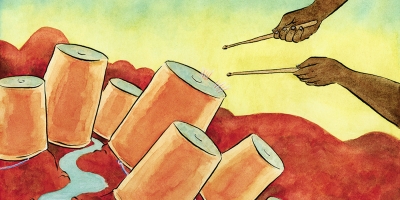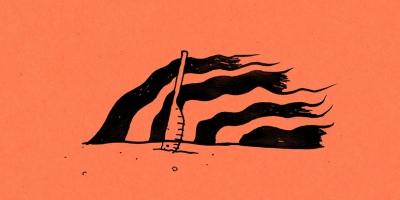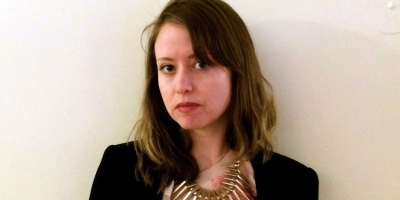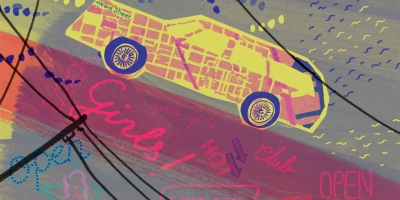In Conversation with
Laura van den Berg
by Sean Carman

Laura van den Berg writes about young women who take jobs as Bigfoot impersonators, start private detective agencies with their sisters, and turn into cannibals when their parents are away.
As playful as her stories are, they’re also built on whip-smart, ambitious foundations. “Opa-Locka,” the story about the sisters with the detective agency, echoes the myth of Orpheus, the Greek hero who persuades the King of the Dead to let him rescue Eurydice from the underworld on the condition he not look back at her during their ascent. “Opa-Locka” also charts a course through other worlds, and its last few pages infuse the admonition “don’t look back” with striking emotional power.
Van den Berg’s debut collection, What the World Will Look Like When All the Water Leaves Us (Dzanc, 2009), established her as a magical and uniquely gifted storyteller, while her follow-up chapbook, There Will Be No More Good Nights Without Good Nights (Origami Zoo Press, 2012), is an under-the-radar treasure. Her third collection, The Isle of Youth (FSG Originals, 2013), established her literary reputation.
This month, Farrar, Straus and Giroux publishes van den Berg’s debut novel Find Me. It is the story of a dystopian America ravaged by an epidemic of forgetting, and one woman, Joy, who is mysteriously immune to the disease. We find her quarantined in a Kansas hospital with other unaffected patients and a team of doctors searching for a cure. Like van den Berg’s stories, Find Me paints a seductive portrait, in clear language and a fluid style, of the surreal worlds moving alongside our own.
Laura and I met at the Tin House Writer’s Workshop in 2007 and have been friends ever since. We spoke by phone about the inspirations for Find Me, the long slog of novel writing, and the probable origin of the zombie apocalypse.
Sean Carman: Joy inhabits a kind of post-apocalyptic America. She’s immune to its epidemic of forgetting, but because she was abandoned as a child, doesn’t know who she is. How did that idea come to you?
Laura van den Berg: A couple of things. In terms of the larger world, I don’t tend to see it as post-apocalyptic, in that it’s more about being on the precipice of The End, as opposed to exploring the aftermath of The End, what’s left after the Big Thing finally occurs. So more a near-future America, an alternate dystopic now.
I started the book in 2008, as we were staggering out of the Bush years. There have been many periods in the last decade when our world, and America specifically, just felt insane. And it can make you feel insane to live in a world that feels so insane. I wanted to capture an American landscape that was badly off-course, already damaged by disaster and perhaps on the edge of even greater disasters.
All that said: Joy—her inner life—was always the heart of the book for me.
Carman: I’m happy to hear you say that about the insanity of our world, because I feel that way and I suspect a lot of people do, too. There also happens to be a lot of dystopian fiction out there right now. Do you think more writers are taking up dystopian stories these days?
Van den Berg: I’ve been thinking a lot about this lately. The New York Times recently did a piece about Emily St. John Mandel’s novel Station Eleven that also discussed the resurgence of dystopian fiction. Certainly there’s been a big wave of dystopian books in the last year or two.
That said, I don’t know that it’s really anything new. The tradition of dystopian literature is long and rich ( Blindness and The Handmaid’s Tale are two “classics” of the genre that come to mind). I imagine that, generation to generation, we all experience passages of time when the world or the country feels off-kilter and doomed. I don’t know that that’s unique to our current moment. I think every generation feels it, and that’s partly what accounts for the endurance of dystopian literature.
Carman: I wonder if our time is unique because we’re facing a looming catastrophe, in the form of climate change, that we don’t seem to be acknowledging, or talking about in a serious way.
Van den Berg: Absolutely. Whether we are actively engaged in that conversation or not, many of us are absorbing that anxiety—the earth is falling apart before our eyes and we know it, and the catastrophe of climate change does feel irrevocable. Things are happening that can’t be undone and the consequences will alter the landscape of the world as we know it. That’s a deeply anxiety-producing prospect.
Carman: How did the idea of an insane, off-kilter world come to express itself in Joy and her situation?
Van den Berg: To me, one of the most exciting aspects of fiction is the way those larger questions about the world can intersect with the deeply interior.
When I was a teenager, I went through a very difficult mental-health patch, and for a while I was in a therapy group of young women. One thing some of them had in common that I did not was that they had undergone staggeringly horrific childhood traumas. In a couple of cases, their memories of these traumas were incomplete. They knew something terrible had happened to them, but key pieces of the information were missing.
At that time, at least, the predominant perspective was that you had to remember the trauma in a complete way—through therapy, hypnosis, and so on—before you could recover. But this was a very complicated endeavor. On the one hand, there’s that pull to try and understand–– Who am I? What happened to me?––and, on the other hand, being terrified to confront what those memories might hold. This was a very long time ago––a lifetime ago, really––but it was nevertheless a haunting struggle to witness and something I’ll never forget.
I can’t say that when I started this project I was thinking concretely of that time in my life, but in hindsight, I think it definitely accounts for some of Joy’s origins.
Carman: You chose a perfect way to portray that sense of personal isolation and the terror of confronting it. How did you make that connection? Or was it always there?
Van den Berg: I think the idea was always there in a half-baked way. But it took me a long time to make the connections. For a while the epidemic was pretty nondescript… It was a little bit more “contagion-esque” and less surreal. I knew it was connected to Joy in a deeply interior way, but it took me a while to understand how exactly. So one thing I had to think about at a certain point was: What does one story have to do with the other? What is this big semi-apocalyptic event doing in Joy’s world apart from creating chaos and putting the hospital situation into motion?
The more I thought about that question, the more the connections between the gaps in Joy’s memory and the larger questions of remembering and forgetting came into play, and the epidemic evolved to respond to those ideas and questions.
Carman: That seems like a productive thing to investigate––the possible connections between Joy’s inability to know herself and her mysterious immunity from an epidemic of amnesia.
Van den Berg: Yeah. I didn’t want it to feel like an epidemic just for the sake of there being an epidemic, just an agent of chaos. I wanted it to have a particular relationship to Joy.
Carman: It’s interesting that when she’s quarantined in the hospital, we learn a lot about the world outside. But when she ventures outside, the story drives into her interior space.
Van den Berg: Yes. In the second part, the chaos of the outside world and the aftermath of the sickness are secondary to Joy figuring out certain things about herself and her history. I see the book as tracking her fight for autonomy and personal freedom, her quest to reclaim the missing pieces of herself. What those gaps in memory mean and don’t mean.
Carman: Did it help that you were drawing on a powerful incident in your own experience? I mean the struggles of the other young women in the group you described.
Van den Berg: I only made the connection between Joy and my own experiences later, but our history is always alive inside us, right? So I’m sure my experiences were shaping Joy’s character, even if unconsciously for a while.
I worked on this book, on and off, for six years. That’s a long time to be thinking about a particular story line. At a certain point, I sat myself down and said, “Why are you telling this story? Why have you stayed with this book as opposed to abandoning it and starting any number of other projects? What is it about this story that keeps you coming back?” That’s when I started to make some connections between my own history and Joy. That opened up the book, gave me a renewed sense of direction. I started to understand what I was writing toward.
Carman: I often wonder if fiction writers inevitably end up writing, in some guise, about their own experiences.
Van den Berg: I think that can be true of the emotional autobiography. I’ve not had many of Joy’s literal experiences, of course. Nor am I living in a dystopia, although sometimes it feels that way… I will say that the isolation Joy feels––the alienation, the disconnection between world and self, not really fitting anywhere––are feelings I’ve experienced. With Joy, they’re just operating on a more dramatic scale.
Also, during the writing of Find Me, I lived in six different states. I lived in Florida for twenty-two years and then Boston for three, and then suddenly I was seeing a lot more of the American landscape. Especially when you spend a lot of time in a car, on highways, in rural areas, in struggling cities. As you know, I lived in Baltimore for three years, where parts of the city look like they could belong to a dystopia. There are so many odd, unsettling sights to see.
Carman: It’s interesting that Joy is trying to get back to Florida.
Van den Berg: I’m convinced the zombie apocalypse will commence in Florida. They say it’s just bath salts, but we know better!
Carman: While we’re on the subject: If there’s going to be a zombie apocalypse––which I think we all agree is likely––where in Florida do you think it will start?
Van den Berg: Oh, good question! In Florida, anything is possible, but I’m going with the Everglades.
Carman: I really liked the conversation you had with Elliott Holt in 2013, when her novel You Are One of Them came out. You described trading pages as you both worked on your novels.
Van den Berg: Elliott and I were working on different timelines, but there was a period when we were both in the murky middle of book-writing, and were flailing a little (at least I was flailing).
Carman: You exchanged pages, but you didn’t read them.
Van den Berg: Yeah, it was too raw. If we knew someone else was going to read our work we would have felt too self-conscious to share it, so this was purely for accountability and process, as opposed to getting edits, advice, etc. It was about keeping us both afloat on a roiling sea. Eventually I read a complete draft of You Are One of Them, and poor Elliott actually read several of my novel, so she should get some kind of writer-friend statuette.
Carman: So you had a weekly deadline?
Van den Berg: Every Sunday, we had to send each other ten new pages. If one of us fell down on the job, and didn’t send her pages, it was the job of the other person to harass her into turning them in.
Carman: How much did it help?
Van den Berg: Enormously. I think one of the most difficult things about writing a novel is that you’re trekking through this desert with no end in sight. So many times when I was working on the book, I would have what felt like a breakthrough and say to a writer friend (possibly to you, Sean!), “Oh my God, I think I’ve figured out the end” or whatever part I was stuck on. And so often that feeling turned out to be an illusion, a mirage that vanished the moment I uttered those words. So if you are engaged in a process that is so long and winding and uncertain, having those mini-deadlines can be helpful in giving some sort of shape to it.
Carman: I know you had written a lot of stories by that time. Had you attempted a novel before, or was this your first one?
Van den Berg: I had, but pretty half-heartedly. I had started a couple of novels, but I would get maybe fifty, seventy-five, or in one case, one hundred pages in before I lost interest and put them down. I have a horror of boredom, so if I lose interest then it’s curtains. Find Me was the first novel that I saw through all the way.
Carman: So maybe NaNoWriMo is onto something with its daily word counts?
Van den Berg: I wrote the first draft of Find Me in 2008. And I approached it in exactly the same way I would a short story––that is, I wrote a draft very quickly, straight through, and it was a giant big mess. I will never do that again.
Carman: Why not?
Van den Berg: Because, for me at least, having a twenty-five-page mess is very different from having a three-hundred-page mess. It took me years just to understand what I had done––what this novel was presently, what it could be, what it should be. To understand where I had taken wrong turns and what the new paths might look like. I’m still not a big outliner. For my current novel project, I’m not making an outline, but I’m definitely moving in a more methodical, more fragmentary way, instead of writing it all the way through in one big rush. A lot more pauses.
I have nothing against NaNoWriMo. If you want to write a novel in a month, more power to you! But having a sea of dysfunctional language to sort through can feel very, very daunting.
Carman: I’ve always thought that about trying to write a novel, that it could quickly become so unwieldy, so overwhelming.
Van den Berg: Oh yes. Big time.
Carman: At the same time, you wouldn’t want to outline it start-to-finish and rigorously follow your outline, I guess?
Van den Berg: I could never work that way. It’s just not the way my brain operates. I’m a little allergic to constraints.
Carman: So are you trying to chart a middle course between those paths?
Van den Berg: If you went through the very first draft of Find Me, I’m not sure you could find a single sentence that’s in the book now. It evolved a lot through the years, and there was a lot of turning away and starting over. When I stopped worrying about finishing it on a particular deadline, stopped worrying about where I was going, stopped worrying about forcing it into a pre-determined shape, when I just sort of let go, and followed Joy’s voice, and went down the odd corners of my imagination, that was when I could feel the book gaining the energy and momentum I was seeking.
I think now I’m a little less uptight about wanting to see the bigger picture. Instead, I’m writing and thinking and waiting for that bigger picture to emerge.
Carman: Can I ask what some of your favorite dystopian novels are?
Van den Berg: I love a lot of the dystopian “classics,” but for some more recent ones, Ben Marcus’s novel The Flame Alphabet is a really interesting book. As is Grace Krilonavich’s debut novel The Orange Eats Creeps. The dystopian part is debatable––depends on how you read the book. The premise is a gang of young people who might or might not be vampires terrorizing the Pacific Northwest––but I really love that novel. Phenomenally energetic. Also, Fiona Maazel’s Last Last Chance.
Carman: What are you working on now?
Van den Berg: Mainly a new novel project. It’s very early, but I tend to think of it as a ghost story set in Cuba. I’m also working on some new stories.
Carman: Will you go to Cuba?
Van den Berg: I desperately want to go to Cuba! But I want to finish a draft of the book before I go. Right now it’s a little too soon, if I’m going for research purposes.
Carman: So many of your stories are about a character who is trying to find something, or solve a mystery or a puzzle. Do you think that’s a pattern in your work?
Van den Berg: The structure of there being some sort of mystery to solve is really interesting to me. I think there’s often a natural resonance between the quest to answer a mystery that has been posed in the world and the quest to address some sort of interior mystery. That’s a pattern I was interested in with Isle, and it’s also a pattern that recurred in Find Me, and it’s recurring in the new project. Those parallels between the mysteries that exist in the outside world and our personal mysteries keep drawing me back.





